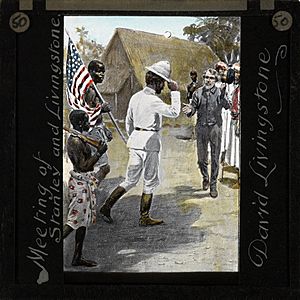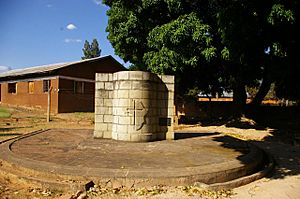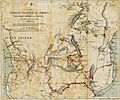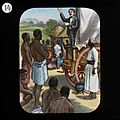David Livingstone facts for kids
Quick facts for kids
David Livingstone
|
|
|---|---|

Livingstone in 1864
|
|
| Born | 19 March 1813 Blantyre, South Lanarkshire, Scotland
|
| Died | 1 May 1873 (aged 60) Chief Chitambo's Village, Kingdom of Kazembe
(today Northern Province, Zambia) |
| Resting place | Westminster Abbey |
| Known for | Spreading of the gospel, exploration of Africa, and meeting with Henry Stanley. |
| Spouse(s) |
Mary Moffat
(m. 1845; died 1862) |
| Children | 6 |
David Livingstone (19 March 1813 – 1 May 1873) was a Scottish doctor and missionary who became a famous explorer during the Victorian era. He is best known for his travels across Africa and for his meeting with Henry Morton Stanley, which led to the famous line, "Dr. Livingstone, I presume?"
Livingstone originally wanted to spread Christian beliefs, but he found it hard to convert many people. Instead, he spent his time exploring and mapping large parts of southern and eastern Africa. He was the one who named the amazing Victoria Falls after Queen Victoria, who was the Queen of Britain at the time.
For his important discoveries, Livingstone received a gold medal from the Royal Geographical Society in London. He also became a member of this society.
Livingstone had a special way of exploring. He usually traveled light, meaning he didn't carry a lot of heavy gear. This helped local chiefs see that he wasn't a threat. Other explorers often traveled with many soldiers and lots of supplies. These groups were sometimes mistaken for armies or even slave-raiding parties. Livingstone, however, traveled with only a few helpers and porters. He would trade for supplies along his journey. He carried only a couple of guns for protection. He shared his Christian message but never forced it on anyone. He understood the ways of the local chiefs and always asked for permission to pass through their lands. Because of this, he was often welcomed and helped.
Contents
Discovering Victoria Falls

Between 1852 and 1856, Livingstone explored deep into Africa. He was the first European to see the giant waterfalls he named Victoria Falls, honoring Queen Victoria. Livingstone was one of the first Westerners to travel all the way across Africa. His main goal was to open up new trade routes and gather useful information about the continent. He especially wanted to see Christian missions and trade set up in central Africa. His famous motto, carved into the base of his statue at Victoria Falls, was "Christianity, Commerce and Civilization." He believed these three things would offer a better way of life than the slave trade, which was still common in Africa back then.
At this time, he thought that sailing the Zambezi River was the best way to achieve his goals. He went back to Britain to get support for his ideas and to publish a book about his travels. During this time, he left the missionary group he had been part of.
The Zambezi Expedition
Livingstone returned to Africa as the leader of the "Zambezi Expedition." This was a project paid for by the government to study the natural resources of southeastern Africa. However, the Zambezi River turned out to be impossible to sail past the Cabora basa rapids. These were a series of cataracts and rapids that Livingstone had not explored on his earlier trips.
The expedition lasted from March 1858 until the middle of 1864. Livingstone was not very experienced at leading a large project. His wife, Mary, sadly died on 29 April 1863 from dysentery. But Livingstone kept exploring. He finally returned home in 1864 after the government told the expedition to come back. Many newspapers at the time called the Zambezi Expedition a failure. Livingstone then found it very hard to get money for more explorations in Africa.
Searching for the Nile's Source
In March 1866, Livingstone went back to Africa. This time he started from Zanzibar (which is now part of Tanzania). His new mission was to find the true source of the Nile River. Other explorers like Richard Francis Burton, John Hanning Speke, and Samuel Baker had suggested that Lake Albert or Lake Victoria were the source. They were partly right, as the Nile starts high in the mountains of Burundi. Livingstone later found the Lualaba River, which flows into the Congo River. He wrongly thought this river was actually the "real" Nile.
Discovering Lakes and Rivers
Even though Livingstone was mistaken about the Nile, he helped Western scientists map many important places. He identified Lake Ngami, Lake Malawi, and Lake Bangweulu, along with Victoria Falls. He also added many details to maps of Lake Tanganyika and Lake Mweru. He mapped the paths of many rivers, especially the upper Zambezi. His observations helped to fill in huge blank areas on maps of Africa. However, he only reached the northern end of Lake Tanganyika, which is still south of the Equator. He did not go deep into the rainforest of the Congo River past a place called Ntangwe.
Meeting Henry Stanley
Livingstone lost touch with the outside world for six years. He was also sick for most of the last four years of his life. Only one of his 44 letters reached Zanzibar. One letter to Horace Waller was shared with the public in 2010. In it, Livingstone wrote: "I am terribly knocked up but this is for your own eye only, ... Doubtful if I live to see you again ..."
Henry Morton Stanley, a reporter for the New York Herald newspaper, was sent to find him in 1869. Stanley found Livingstone in the town of Ujiji, on the shores of Lake Tanganyika, on 10 November 1871. Stanley greeted him with the now famous words, "Dr. Livingstone, I presume?" Livingstone replied, "Yes," and then added, "I feel thankful that I am here to welcome you." Some people think these famous words might not be true, as Stanley later removed the pages about this meeting from his diary. Even Livingstone's own account of the meeting doesn't mention these exact words. However, the phrase appeared in a New York Herald newspaper article in 1872. The words are famous because they seem funny. Livingstone was the only other white person for hundreds of miles, and Stanley's greeting sounded like something you'd hear in a fancy London club.
Stanley joined Livingstone, and they explored the northern part of Lake Tanganyika together. Stanley left in March of the next year.
Death
Even though Stanley urged him to leave, Livingstone was determined to stay in Africa until his mission was finished. His illness made him confused, and he had trouble making good decisions near the end of his life. He even accepted help from Arab slave merchants who were looking to capture slaves. They used him to make contact with local people. He died in chief Chitambo's village, near Lake Bangweulu, in Barotseland (which is now Zambia). He passed away on 1 May 1873 from malaria and internal bleeding caused by dysentery. His loyal helpers, Chuma and Susi, carried his body over a thousand miles. His body was then returned to Britain and buried in Westminster Abbey.
Images for kids
-
A new statue of David Livingstone on the Zambian side of Victoria Falls
-
Livingstone statue, Edinburgh by Amelia Robertson Hill
-
Livingstone statue, Glasgow
See also
 In Spanish: David Livingstone para niños
In Spanish: David Livingstone para niños




















